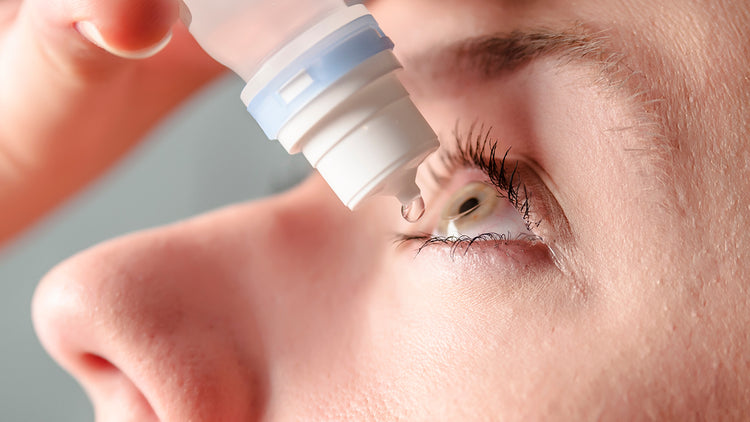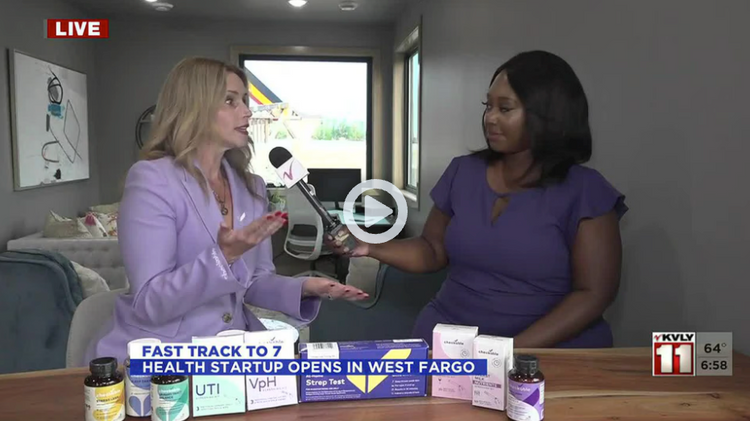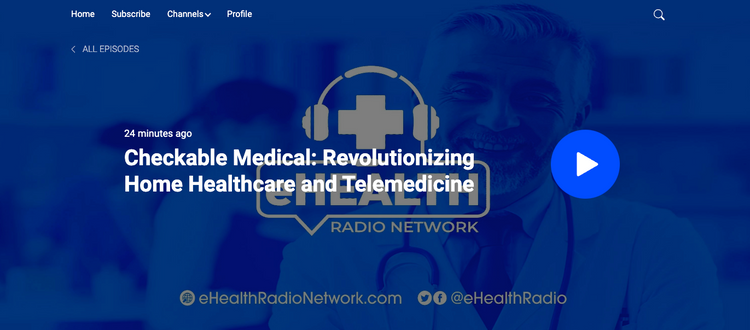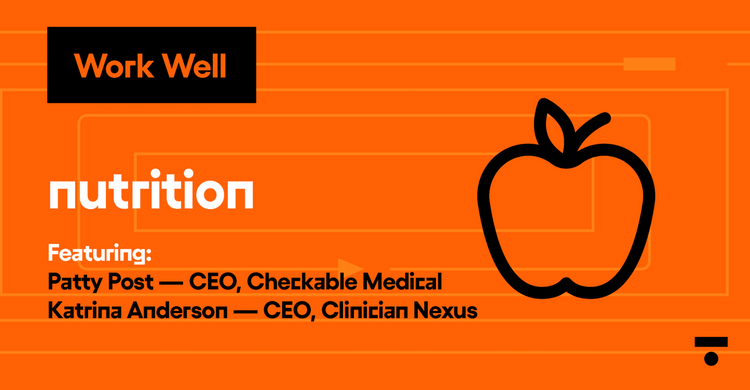
Are you a busy mom, a career-focused woman, or maybe you're both? Are you wondering how to equip yourself better to avoid injury in your high-paced day-to-day? Join our conversation to hear from Occupational Therapist and Certified Ergonomic Assessment Specialist Crystal Nelson. Crystal is the founder of Fargo Ergonomics and Alter Ergo, an online platform that gives you access to digital tools to help improve ergonomics fast and easy.
In this episode, learn simple tips and tricks to help you improve your daily life by avoiding unwanted injuries by creating ergonomics that work for you and your family.
Learn more about Fargo Ergonomics and Alter Ergo.
Check out our podcast selection for valuable info on health, wellness, and more.
Continue the conversation in the Hero Moms Social Group on Facebook!
Connect with Checkable Health:
Facebook
LinkedIn
Connect with Patty Post:
https://www.linkedin.com/in/patty-post/
About Checkable
Checkable is revolutionizing healthcare with fast and accurate at-home test kits, telehealth services, and a line of wellness supplements designed to keep you feeling your best while saving valuable time and money.
At the forefront of home healthcare, Checkable is developing the first FDA-approved at-home strep test. Paired with a proprietary digital telemedicine platform to instantly connect consumers with healthcare professionals, you can skip the doctor's office and start treatment fast, right from the comforts of your home. http://www.testforstrep.com
Full Episode Transcript:
0:00:00.1 S1: Ergonomics is something that we associate with the workplace, yet it is so important to think of it as part of a holistic lifestyle and preventative care for both ourselves as well as our families. Crystal Nelson is an occupational therapist, certified ergonomic assessment specialist, and owner of Fargo Ergonomics as well as a sister company called Alter Ergo. She lives to educate people on the importance of ergonomics. Today, Crystal joins me and shares tips and tricks that you can implement into both your workplace as well as in your home life.
0:00:41.0 S2: Welcome to the Wellness Essentials Podcast, where we invite you to join the conversation and get inspired to be in the driver’s seat of your health and well-being. On this podcast, you'll get an all-access pass inside the minds of MDs, experts and thought leaders in the industry. No topic is off-limits, and we're asking the questions to get you the answers across the gamut of topics when it comes to optimizing your health. This is the WE Podcast.
0:01:21.0 S1: Thank you guys so much for tuning in to this episode of the Checkable Health podcast, where today we're gonna be talking with Crystal Nelson about ergonomics, and especially as a mom, how this plays a role in your life. So Crystal, do you wanna share a little bit about your back story about your companies and your love of ergonomics? Absolutely, I'd be more than happy to. So when I was going to college to become an occupational therapist is when I first learned about the idea of ergonomics and I was instantly attracted to this idea of injury prevention, I also was very interested in our whole bodily systems and how they all function together, but the way we can improve our lifestyle and our health and wellness was very interesting to me. So then after college, shortly after that, one of my first jobs was in an outpatient clinic, and I helped rehab plenty of upper extremity injuries, and many of those were musculoskeletal disorders, and that's an injury to the soft tissues of our body, so muscles, tendons and ligaments, injuries that occur because of repetitive motions or awkward positioning or heavy lifting could be easily prevented.
0:02:41.2 S1: So in 2010 was my first ergonomic assessment, and the instant gratification that the client had received was outstanding. I also was very interested in helping to stop some of these injuries that were happening instead of me being in a clinic and treating them. I definitely get a lot of joy from helping people and improving their lives, so this was just the icing on the cake. I really enjoyed just a small adjustment to help improve someone's life. So then a few years after that, I did become a business owner and I had an outpatient clinic where we had PTs and OTs to just help address some of those needs in our community, and then once I got pretty comfortable as a business owner... Again, I thought about ergonomics. And I figured, okay, so if I can create this outpatient type business, what could I also do with ergonomics? So I registered the business name Fargo Ergonomics, about a year and a half into being a business owner, and I didn't know what I was gonna do with the business name, I didn't really have a clear plan. All I knew was that I was going to create a business with a focus on ergonomics and maybe provide some ergonomic assessments here and there. So then after a year of registering the business name and just talking about it with other healthcare professionals, friends and families, I started to get referrals, and I was in our community helping people, and it was clear to me that that path in my career is where I needed to be. It was much more enjoyable working with all the people in our community directly brought me a lot of excitement too.
0:04:30.8 S1: So then I had to figure out, Okay, so how am I gonna do this? How am I going to have an outpatient clinic and this other business? And it seemed to be a bit more stressful than I was interested in at that point. So then I did figure out a way to just put all of my energy and my passion into the local business Fargo Ergonomics, and then that has been doing well. There's been a lot of great opportunities within that company, and I would say, I think it was last year...so 2021, that I created an e-commerce business called Alter Ergo, so instead of being on site, which I can't be everywhere, I created this e-commerce business so I could do virtual ergonomic assessments for any business anywhere, and my goal is just to provide plenty of education and training opportunities that are free, so people can access this information because finding information about ergonomics, even though it's not a new idea, it is kind of difficult to find a good, reliable resource. And I'd love to be that person that people can go to to find that information. So my full life is all about my passion of ergonomics...
0:05:48.6 S1: Oh, and my family too. My kids and husband. That is so true. Yes, Crystal is a mom of four, and we have a lot of moms that are listening in, and I love that you can come from a standpoint as a mom as well as a professional in ergonomics, and can you share a little bit about like... Give us some tips or tricks? Because us mamas need to know how to move our bodies, and when it comes to our kids…picking up our kids, we got a baby on one hip, a toddler on the other. Can we bring some of these ergonomics home? Yes, absolutely. So ergonomics, like you said, it doesn't just relate to the working person, it also relates to all the tasks we're doing in our home environment, even driving as well. So as a mom, many times you're picking up something, whether it's a toy or a child, or maybe a bin, who knows what it is, but the main thing to start with is just to practice good lifting techniques. So if you are lifting a very lightweight item such as a toy, the proper lifting techniques are the same as if you are lifting for me. I like to lift my eight-year-old, so I still need to practice those safe lifting techniques no matter what the weight is.
0:07:09.5 S1: So the goal is to squat with your back upright without bending forward at your hips, so your knees and your legs do a lot of the work. So once you squat down into the needed position, then you grab the toy or even your child and bring them close to you, so you don't have to keep your arms extended as you're standing. So the goal is to keep them close to you, so your arms and the weight of the child is close to your body, then it's a lot easier for your body to stand appropriately without straining your muscles too hard. Once you're at that point where you're ready to lift, you wanna keep breathing, don't hold your breath, and then stand up with mostly your legs and try not to lean forward with your arms close to your body, too. That's one of the main things, is make sure you practice safe lifting techniques, the other one that comes to mind would be for new mamas, or moms with young babies, where I remember feeding my kids or just looking at their cute little baby faces, and I realized my head was forward flexed for a good portion of the day, and that can cause a lot of neck strain and neck fatigue. So just be mindful of when you're feeding your baby is to switch the baby from one arm to the other, breastfeeding moms have it a little easier because you naturally are switching from side to side, but if you’re bottle feeding, just be mindful that some feedings, you'll have the baby in your left arm and then the next feeding you'll have your baby in the right arm. So even if you're right- or left-hand dominant, it may feel a little funky to go to that opposite side, but it's good to use both upper extremities equally. And then while you're holding baby, you don't always have to hold your baby in the nook of your elbow, you can hold your baby right in front of you and bring their face a little closer to you as well, so you aren't always looking down and off to the side.
0:09:11.9 S1: Oh, I love those simple tips and tricks that can really help the mom out just so she can be more mobile and play with her kids, so I really like that. Let's dive in a little bit to the workplace, so we got some working moms out there who are in the office. I kinda wanna dive into some tips and tricks for the office. So my first question for you is, how does sitting or standing incorrectly during your work impact your health over time? So there are a lot of contributors to the way we feel throughout our day. So it could be an awkward posture, it could be from the food we're eating, it could also be from the amount of water that we're drinking in a day, but as far as ergonomics goes, the best thing is to make sure you're supported in an upright posture. So when you are leaning to the side are not fully supported, that's considered an awkward posture, especially if you end up hunched over and slouched, and what happens then is your primary muscles, we have a group of primary muscles and a group of secondary muscles, so these primary muscles are the ones that are solely responsible for a certain job. So if those primary muscles are being taxed to a certain point where they become fatigued, our brain sends out a message and says, Oh hey, we need some backup here, these muscles are getting tired, who else can help out, so then the secondary muscles try to kick in and they try to do the job of those big, strong primary muscles.
0:10:51.3 S1: So when the secondary muscles are also trying to help out, plus we have the original muscle that is fatigued already, that's when we can start to feel some feelings of discomfort or start to get the onset of some of those musculoskeletal disorders. So the main thing is just to practice that good upright posture and to use your supports around you as well. Those are some great tips, especially in the office when we can get really into our work and sit for hours at a time, and then look up and it's... Oh my goodness, it's noon or it's three. Do you have any recommendations for the office, like how long to be sitting, should we always be standing? What are your thoughts on that? So the goal in ergonomics is to be in a variety of positions as often as you can throughout the day that are supported. So a general rule of thumb is to sit for 75% of your day and to stand for 25% of your date, but you don't want to chunk all of that together at one time, so you don't wanna sit for six hours and then at the end of the day you stand for two hours, 'cause now you have two sustained positions where you're not moving, so to get into the routine, use your resources, use your alarm on your computer, use your watch, use your phone, whatever it is, to start to get into this habit of getting up once per hour.
0:12:23.8 S1: So the goal is to stand for five to 15 minutes per hour. So if you have a height-adjustable desk, that's where those come in handy because it's a lot easier to stand and move about with the situation like that, if not get around and move about your office. Walk down the hallway if you can. If you're working from home, walk throughout your home as well, it doesn't have to be stuck in one place. And also consider your job tasks too where if you are attending maybe a webinar or you're taking a phone call where you don't have to reference your computer, then get up and move around with a wireless headset, so you can attend to some of those tasks as well. There is another rule called the 20-8-2 Rule, this was developed by Alan Hedge, he's a professor of ergonomics at Cornell University, so he developed the idea that we should change our positions at least every half hour, so the 20 stands for sitting for 20 minutes, the eight is standing for eight minutes, and the two stands for moving about and stretching for two minutes, so every half hour you repeat this, and once your body gets into the routine of things, you won't always need to rely on the time or a reminder, your body will tell you what you need.
0:13:52.1 S1: So your body may say to you, not literally, but your body may tell you that you're feeling uncomfortable, you're starting to feel fidgety, or maybe you're having a tough time focusing, at that point consider... Well, when was the last time that you were able to stand up and move around? And I would bet that it would be at least an hour where you hadn't moved around, so once you're into the routine, then you can depend on listening to your body and listening to what your body's needs are. Oh, those are some great tips, I'm really excited to try these out myself, and it's so true what you say, our bodies do communicate with us, we know our bodies, our bodies talk to us if we listen, and that's such a great way to just implement some of those tips like, start using your phone and then your body will naturally start to take those forms and want those forms that changing it up. That reminds me too, I'm so lucky at the Checkable office because we have a great treadmill desk, we have a couple of yoga mats and we're able to move around freely, so I think that's great to see businesses also stepping up in a lot of cases to...
0:15:07.9 S1: Encourage employees to move about their office and help stimulate blood flow as well as brain activity and just keep you feeling good. Okay, so you know, kind of like going on that, what are some of the health impacts for people who sit at desks throughout the day and don't get up, what are some of these disorders that happen? So the amount of issues that can happen for, I’ll call it a sedentary lifestyle, is a very lengthy list, so there was a marketing initiative not long ago, and it said that sitting is the new smoking. So a very extreme marketing plan, but what they were trying to say is that a sedentary lifestyle has the same unwanted health risks as smoking does. So you want to avoid that sedentary lifestyle. What does the data around health impacts for people who sit at their desk all day and don't get up and move a lot, some of those disorders that can happen and disease? So when you have a sedentary lifestyle, you put yourself at a high risk for many issues, cardiovascularly, muscularly, many things that relate to your body. So when you sit and don't move about, you’re burning less calories, you may lose muscle strength and muscle endurance because your muscles aren't as active. So standing and moving about is a higher level task than sitting, there are some studies where that they say your bones could get weaker and lose some mineral content, our metabolism could be affected, our immune system, our blood circulation, even some inflammation and hormonal imbalances have been noted in some scientific studies as well, but as far as the overall list of issues that could go wrong, it would be obesity, heart disease, blood pressure, high cholesterol, stroke, type 2 diabetes, cancers, osteoporosis, and even some feelings of depression and anxiety, so really the risk of a sedentary lifestyle will dramatically remove years from your life because of the negative effects of it. That is so true, and these these...
0:17:41.4 S1: I've been hearing these findings as well, and I think it's something to definitely take note of, and myself included, I sit for most of my day, I am on my screen like many of us, and just to know these things, like the preventative care that you provide with ergonomics, and that we can kind of just get into is like taking small preventative measures to help reduce some of these risks, so I really appreciate people like yourself who's bringing us those methods and tips and tricks, you guys. So I kinda wanna dive into one topic, speaking of sitting... What are we sitting on? We are sitting on office chairs, sometimes I'm sitting on my couch, it depends. Can you share a little bit about the importance of our sitting situation and the chairs we should be looking at? Sure, I'll focus solely on office chairs just because that provides us with an option for more support, so the one thing to look at when you are shopping for an office chair is just to consider what your job needs are, if there are certain materials that you need to consider if you're working in an area where there is a high level of dust and debris or if it's clean, if you're working in a cooler environment or warmer environment, those are all areas to consider along with weight capacities of chairs, so...
0:19:08.2 S1: Most chairs are designed to support 250 pounds, so if you're greater than that, just be mindful to look for a chair that supports the weight that you might need. So the main thing to start looking for is... Material is an important piece of it. You wanna make sure that the material is breathable, so some materials don't allow for our skin to basically breathe, so think of maybe a plastic or fake leather type material. So with that type of material, our bodies may sweat a little bit more, and they have a tough time staying cool, so you may feel a bit more tired at the end of your work day because your body was trying so hard to keep you cool. The main items to look for is making sure that the adjustability of the chair fits your needs, your hips, knees and elbows should all be at 90 degrees, so make sure your chair can go low or high enough to get to that position. Your knees and your hips can be anywhere from 90 to 100 degrees, it doesn't need to be right at 90, you can move a little bit throughout your work day. With your seat pan, you wanna make sure that it can move forward and back to also access your needs, so the front part of the chair should be about an inch…
0:20:32.9 S1: from the back of your leg, if that seat pan is too short, then most of the force and weight from your upper body is directed down toward your low back and hips, and that can create some feelings of discomfort. So our joints are not designed to support us, so we want to avoid putting all the force into our joints, where instead you wanna have that seat pan that fully supports your thigh, because we do have a nice strong thigh and a long femur to help support those needs of our body. Once you have found a car that has a seat pan that fits you and a height that can get to your needs, then also look at your armrests. So armrests should support you where your elbows can rest anywhere from 90 to 100 degrees in about a 20-degree angle from your side, you don't want your elbows to be sticking out too far, but you don't want them pressed in by your sides either, just gently relaxed by your sides. So in order to figure out the height of your armrests, I recommend bringing your armrest height all the way down, relaxing your shoulders down and back, and then bringing your armrest up to your elbow height when it's bent to 90 to 100 degrees. And then the other thing to consider is your backrest, making sure your backrest is fully supporting your back from your low back to your mid-shoulder blade and one that can support you in more of an upright position, you don't want to be reclined too far, you also don't want to be perched forward too far either, so there are many chairs available, you do wanna spend a decent amount of money on a chair you get what you pay for because you are sitting for most of your day too, so you do want that to be one of the bigger investments within your office.
0:22:24.8 S1: That's so true. It's like, invest now and save yourself medical bills later. Or save yourself a lot. That's incredible. Is something to really think about. A lot of times we overlook these things... I know I do, I would never really think about that, but it's so important to think about just like where you're spending most of your time, you want that to be positioned well... I appreciate that. Does having a healthy mind and healthy body always seem to be a bit out of reach? I'm here to let you know the Checkable team is in your corner when it comes to healthcare, our selection of supplements were chosen to address everyday health challenges, so you can live your healthiest and most vibrant life. Checkable products were made to be convenient and to fit into your busy life. They're formulated to be easy to absorb, so you can begin to feel and see the results faster. If you're ready to start looking and feeling your best, visit our website, checkablehealth.com and find the right supplements for you with Checkable, your healthcare begins at home. There's a lot of talk about pelvic floor health lately, we've been hearing about pelvic floor, and I'm curious, is there ergonomics that support or that impact the pelvic floor health? Absolutely, so poor posture, especially in a seated position, can affect your pelvic health. So your pelvic floor, that’s the layer of muscle that spans the bottom of the pelvis and it supports your pelvic organs. A well-functioning pelvic floor helps with your bladder and bowel control, so in both areas, the pelvic floor doesn't function alone, it also works with your diaphragm, your abdominal muscles, and even some of your spinal muscles too. So if you are demonstrating a poor posture, that would be one where you're slouched down a little bit more, or one that could be considered an awkward posture where you're perched up more upright, where your spine may be curved in the opposite direction, so if you end up into a position where your pelvis is shifted and rotated where you end up putting more weight on your tailbone that can cause a lot of pressure, aches and pains on your tailbone, it also compresses your bladder and your bowels as well, so that can cause some difficulties in that area when you do end up in that...
0:25:04.1 S1: poor slouch position. The other end of the spectrum is if you're perching too far and trying to sit too far upright and your back is arched forward a little bit more, so that can cause some pain and tightness in your pelvic floor as well. So you want to be sure to avoid both positions and be in a neutral position, so a neutral position is with your pelvis upright and some of the weight should be distributed to your buttocks, and there's a bony part of your buttocks called the ischial tuberosity. So that is an area that you may feel when you are sitting more upright and more in a neutral position, you don't want to feel that you're sitting on your tailbone, you don't want to be feeling like you're leaning forward too far either. So a nice neutral position with the muscular part of your gluteus maximus supporting you in that seated position. So also consider the seat pan that you're sitting on and the cushion you’re sitting on. You want it to be firm and supportive, but you don't want it to be too firm where it's causing areas of pressure, you don't want it to be too soft because then it's not supporting your posture and you end up kinda slouching down, maybe like you would in a movie theater or relaxing on your couch, which those are okay positions to be in short periods of time, but not for long periods while you're completing your work day. And then just make sure that your legs are both flat on the floor or your feet are both flat on the floor, try to avoid crossing your legs, especially at your knees.
0:26:45.1 S1: This is one habit, if you are going to take home a new habit today, I want you to stop crossing your legs at your knees, if you want to transition away from that habit, you can cross your legs at your ankles, and then once you are comfortable with that and you have noticed that you're not crossing at your knees as frequently, then you can try to progress into just keeping both feet flat on the floor as often as possible. Well, I'm gonna uncross my legs right now 'cause you guys, my legs are crossed, so I’m gonna do that, and take that advice and... Yeah, that is so true. And that's something that we habitually kinda just do, so it's nice to know some options, and it kind of makes me think too, finding that seat comfortability is very... It's like Goldilocks. Kinda like Goldilocks. So you find that just right seat for yourself. Absolutely, and that's a good thing that you mentioned that too, when you are looking for that just-right chair, make sure you sit in a chair, make sure you try it, it's really hard to buy an office chair thinking it might fit you without having any time seated in that chair...
0:27:55.3 S1: This is so true. I think this kinda comes into play, especially now, as we find something that looks good, ordering it online. Do you have any great resources for good chairs where people can go and try them out? Depending on the size of city that you live in, your bigger cities will have your office furniture available on site to try it. I am working on a series of videos that will be launched this year, and one of the videos is I have four different body types and styles trying many different chairs that are out there, so different heights and different weights available, and then they give their honest opinion on what chair feels better to them. So if you don't have the resources to try a chair, you can see how one of the chairs that I like may fit you and your needs, so stay tuned for that. Oh, I'm so excited. Is that gonna be on Alter Ergo? Yes, yes. So that'll be on the website, youralterego.com, or there is a YouTube channel that is coming our way as well. Oh my goodness, I'm so excited for that.
0:29:09.7 S1: What great resources you guys. You literally can just with a click of a button, there is Crystal and she's explaining these things... That's so cool, I absolutely love that. It kinda leads me to my next question actually, because just being a teacher yourself, of ergonomics, how can we bring some of these great tactics home to our kids and start teaching our kids? One of the main things we, I wanna say... I don't wanna say need... That sounds like such a strong recommendation, but it is so important with today's generation, but if you can, I would highly recommend just to help educate your kids on the positioning of their electronics. So naturally, when we hold a phone, a gaming system, tablet, you name it, we end up holding it close to our body, so our neck ends up being flexed more than what is comfortable or what is needed, so tell your kids and tell them why, they'll be much more responsive if you tell them why, just to hold their electronic devices up a little bit more so they're closer to the front of their face so they can keep their head in that neutral position. If you have older kids also tell them to tuck their chin back a little bit as well, almost creating somewhat of a double chin. By practicing these two items, you can promote that upright posture, so your kids don't have issues later on in life, even though they're young and healthy now, these can be little contributors as they continue to age and they may be more susceptible to an injury as they get older.
0:30:58.7 S1: No, Crystal, that's a really good point, because when we were kids, we weren't really introduced to... well, give or take a few years. We were introduced to computers later on and didn't have phones until maybe our teen years, but now we're seeing kids start very young with electronics, so they're gonna have a lot more wear and tear on those muscles, joints and everything than we did even at that age or not maybe see some things changing with our kids in the future, so... That's a really good point. Yes, and there are even terms that have been developed such as Text Neck to refer to this awkward position. Another way to encourage that upright posture is to have your kids rest their tablet on a table top or a desk so they can relax back in their chair, and watch their video in a neutral posture. I like that they're developing some of those stands and different ways too that you can prop things up, so this has been a really great conversation, and I think these are some great take aways, just that we can start implementing into our daily lives, get our kids excited about it, being healthy and just starting the conversations young.
0:32:14.1 S1: So Crystal, I'd love to connect people. You said you had the websites and you have social media that you'd like to share, share all the goodness with us. Sure, absolutely. So a lot of the social media is in the process of being developed at the time of this podcast, but the handle is at FargoErgo for my local company, Fargo Ergonomics and for the e-commerce company, Alter Ergo, the handle is at YourAlterErgo. You can find me on YouTube videos, Facebook, Instagram, and I'll have some quick TikTok tips as well. I love that, getting on the TikTok. That'll be super fun. Well, thank you so much, Crystal, for your time today, for sharing your insight with us and as a mom and as well as a professional, so we really appreciate that. Thanks for having me, I always enjoy talking about ergonomics. Wonderful. Thanks guys for tuning in to the Checkable Health podcast, where we connect you with great resources like Crystal to help you busy moms that are health conscious, live well and be well. Thank you guys.
0:33:32.7 S2: Thank you so much for tuning in to today's episode. We hope you got a lot out of it. If you haven't already, be sure to subscribe to our podcast so you can stay up-to-date with our latest episodes. Also, you can find us on social media by searching, Checkable Health. We look forward to seeing you again soon.
Life is too short to sit in a doctor’s office
Sign up for our weekly newsletter and get valuable healthcare tips and tricks in your inbox!
Sign up now and unsubscribe anytime.
- Choosing a selection results in a full page refresh.
- Press the space key then arrow keys to make a selection.
























































































